Through its century-long history, the Communist Party of China (CPC) has nurtured a series of spirits, which reflect the theme and essence of the centennial history of the Party and provide the strong spiritual motivation to the great rejuvenation of China.
The spirits of the communists in China are a gigantic system and entirety with the same roots and origins. These great spirits were born and developed during the CPC's journey in revolution, construction, and reform and opening-up through historic events, locations and figures.
The spirits are also a reflection of the long-standing and well-established spirits of the people of China - creativity, hardworking, solidarity and having dreams.
The sixth plenary session of the 19th Central Committee of the CPC held between November 8 and November 11 is crucial as it's the Party's first major political event after celebrating its 100th founding anniversary.
The Global Times has dedicated three issues to illustrate the precious spirits of the CPC that have been formed and inspired Chinese people in the Party's centennial history.

The First National Congress of the CPC was held in a red boat in Jiaxing, Zhejiang Province in July 1921. Photo: VCG
The founding of the CPCFounding Spirit of the CPC
The founding of the Communist Party of China in 1921 was a milestone in history. A hundred years ago, the pioneers of communism in China established the Communist Party of China (CPC) and developed the great founding spirit of the Party, which is based on the following principles: upholding truth and ideals, staying true to our original aspiration and founding mission, fighting bravely without fear of sacrifice, and remaining loyal to the Party and faithful to the people. This spirit is the Party's source of strength. Over the past hundred years, the CPC has carried forward this great founding spirit and has developed a long line of inspiring principles for Chinese communists.
New Democratic Revolution
Jinggangshan Spirit
Jinggangshan is known as the cradle of the Chinese revolution. The Jinggangshan Spirit is defined as "overcoming difficulties with hard work and relying on the masses for victory" and was conceived through the arduous struggle. It is the source of the Chinese communists' revolutionary spirit.

Jinggangshan Photo: VCG
The spirit of the Soviet areas
The forerunner of the People's Republic of China, the Provisional Central Government of the Chinese Soviet Republic, was founded in Ruijin, East China's Jiangxi Province in 1931. This spirit nurtured in the revolutionary base in the Soviet areas features a firm conviction, a realistic and pragmatic approach, wholehearted service to the people, integrity and diligence, pursuit of excellence, and selfless devotion.
Long March Spirit
From October 1934 to October 1936, the CPC followed its own strategy by leading the main forces of the Chinese Workers' and Peasants' Red Army on a trek of 25,000 li (12,500 km) from its bases in South China to the Party's enclave in northern Shaanxi Province. Known as the "Long March," this epic effort created a legacy of revolutionary idealism and started a new great march toward national independence and people's liberation.
This is a spirit of strong beliefs, of fearless resolution to surmount difficulties at any cost, of firm discipline, and of Party unity.
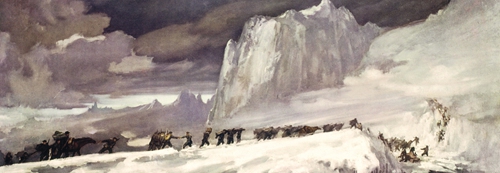
A painting illustrating troops climbing the snow mountain during the Long March. Photo: VCG
Zunyi Meeting Spirit
The Zunyi Meeting is known as an important wartime gathering in the history of the CPC. The meeting established Mao Zedong's leadership in the Red Army and the CPC Central Committee, and marked the formation of the first-generation collective leadership of the CPC represented by Mao Zedong. It was a historic meeting and a turning point in CPC history. The success of the Zunyi Meeting relied on firm conviction, a realistic approach, pursuit of independence, the courage to blaze new trails, democracy and unity.
Anti-Japanese War Spirit
From September 1931 to August 1945, the Chinese people resisted Japanese aggression and made a great contribution to the victory of the world anti-fascist forces in World War II. During this bitter struggle they developed a spirit of resistance against aggression with patriotism at its core.
The spirit includes: patriotism that inspires the individual to work for the wellbeing of the country; dauntless national character that prepares to sacrifice oneself for the greater good; heroic valor that nurtures a national will to confront brute force and fight to the last; great perseverance and an unfailing belief in victory; and national unity to achieve victory over foreign aggressors.
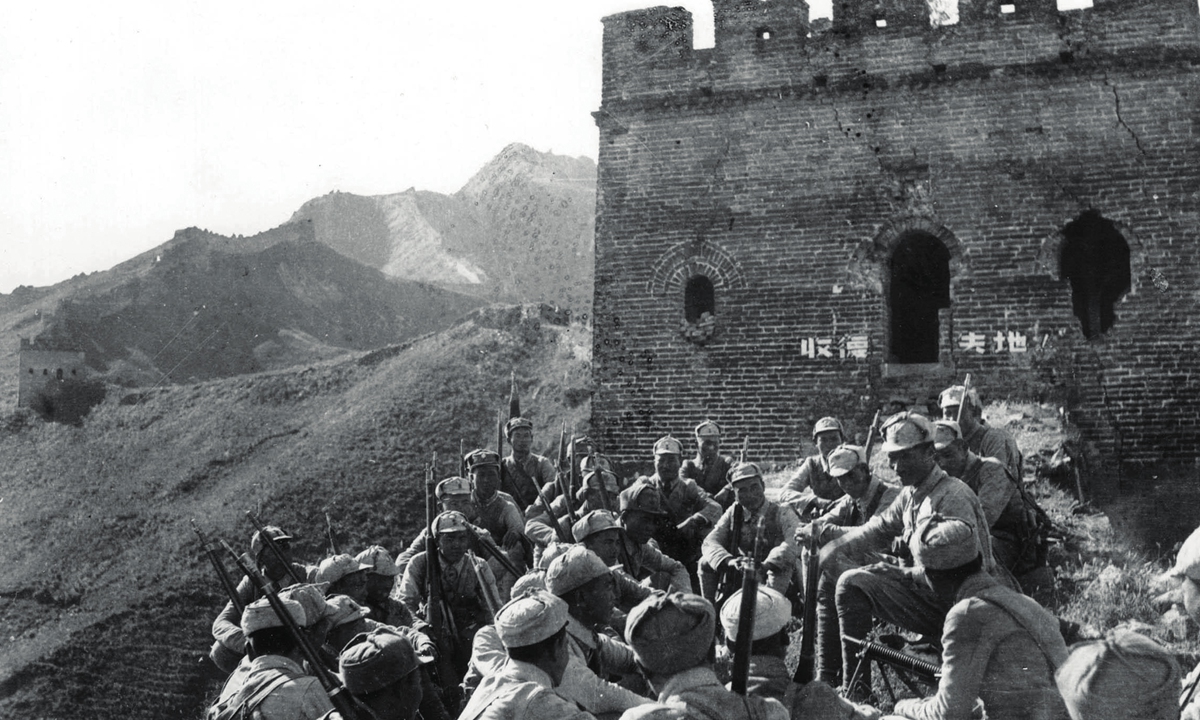
After a battle in the spring of 1938, the Eighth Route Army troops hold a meeting on the Great Wall in Baoding. Photo: VCG
Yan'an Spirit
Yan'an was the base of the CPC during the 1930s and 40s and is a shrine of the Chinese revolution. The Yan'an Spirit, fostered by revolutionaries and communists of the older generation, has become an invaluable source of inspiration for the Party.
The spirit of the revolutionaries at the Red Crag, Zhaojin Spirit, Northeast Anti-Japanese United Army Spirit, Nanniwan Spirit, Taihang Spirit (Lüliang Spirit), Dabie Mountain Spirit, Yimeng Spirit, Old Revolutionary Base Areas Spirit
These names pay tribute to the remarkable revolutionary locations that gave birth to the spirit, with the guts and blood of the communists, that was present in the journey of the CPC in those harsh years. For example, the Nanniwan Spirit, fostered by the people's army under the CPC leadership, is a powerful belief in self-reliance in the face of difficulty and hardship.
Zhang Side Spirit
Zhang Side (1915-1944), a soldier in the Guards Regiment of the CPC Central Committee, sacrificed his life to save his fellow soldier in an accident. The essence of the spirit of Zhang Side is living frugally, working diligently, and being prepared to die for the people.
Xibaipo Spirit
The spirit of Xibaipo, defined by Mao Zedong in April 1949, is "to remain modest and prudent, struggle on tirelessly, and rely on the people to attain solidarity and unity."
Socialist Revolution and Construction Period
The Spirit of Resisting US Aggression and Aiding Korea
In the War to Resist US Aggression and Aid Korea (1950-53), patriots formed the Chinese People's Volunteers Army to firmly cross the Yalu River. They bravely faced enemy gunfire and the extremely cold environment and won the war with their blood and lives defending peace and justice.
The Spirit of 'Two Bombs and One Satellite'
In the 1950s and 1960s, Chinese researchers, full of patriotic enthusiasm and ambition, worked together under extremely difficult circumstances to overcome numerous technical difficulties. They successfully developed nuclear bombs, ballistic missiles and artificial satellites, demonstrating the strong determination and ability of China to stand self-reliant on the world stage.
Lei Feng Spirit
The inspiration named after Lei Feng, a PLA soldier renowned in China for his generosity and altruistic deeds who died in the line of duty, includes the spirit of dedication to serve the people and the professional dedication to reach extraordinary achievements in ordinary tasks.
Jiao Yulu Spirit
Jiao Yulu was the Party secretary of Lankao county in Central China's Henan Province in the 1960s, who worked hard for all the people and devoted his life to improving the quality of life in the region while fighting sandstorms, poor soil and floods. The spirit displayed by Jiao Yulu was exemplified by his love for the people, a perpetual sense of his mission to serve the people wholeheartedly, his frugality, his tenacious struggle with nature and his honesty among other virtues.
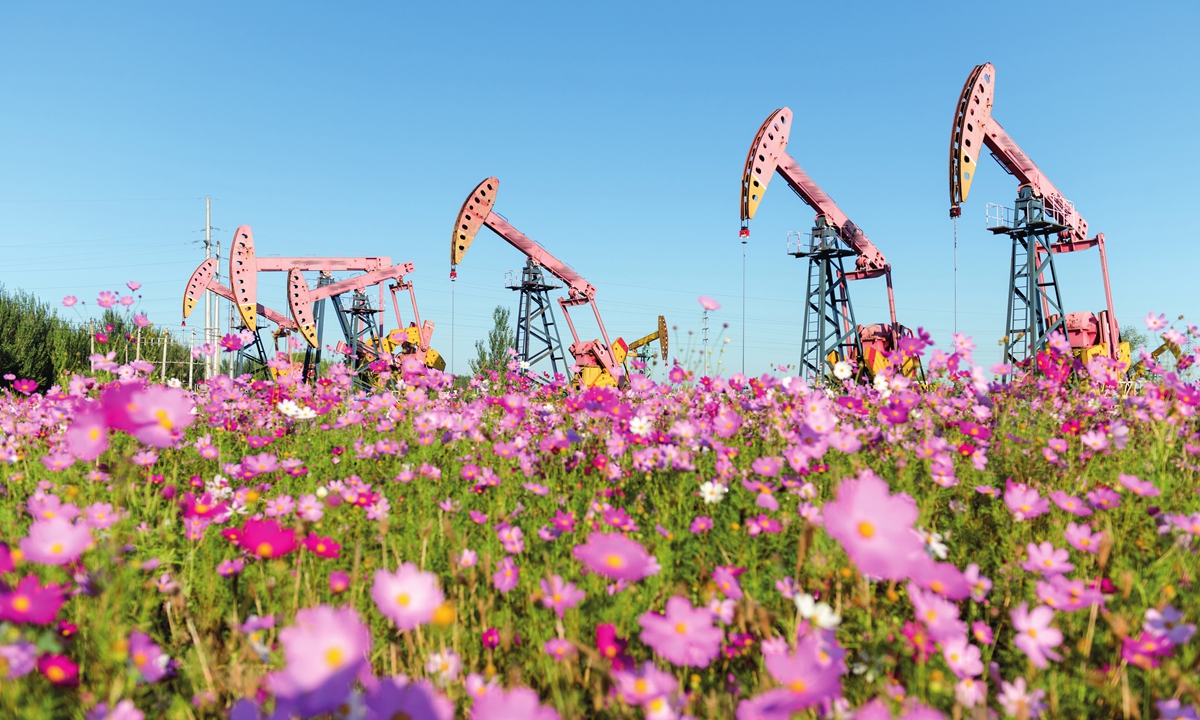
The Daqing oil field Photo: VCG
Daqing Spirit (Iron Man Spirit)
In the early 1960s, Chinese oil workers and geologists overcame countless hardships to discover the Daqing oil field in the Songnen Plain, Northeast China. During the exploration and construction of the oil field, the workers, represented by Wang Jinxi, were like iron men and worked hard in the wilderness to build Da-qing into the largest oil production base in China and a world-class oil production hub at that time.
Hongqi Canal Spirit
In the 1960s, 300,000 people in Linxian county, Henan Province, spent ten years to build the 1,500-kilometer-long Hongqi Canal on the cliffs of Taihang Mountains. The work was carried out under extremely poor material conditions to divert water from Shanxi Province, changing the problem of water shortage in the region since ancient times.
Beidahuang Spirit
In the early 1950s, 100,000 soldiers arrived in the barren Sanjiang Plain, Northeast China's Heilongjiang Province and launched a large-scale development and construction campaign, changing the wilderness into a rich granary.
The Spirit of Afforestation Workers on Saihanba Highland
Since China established a forest farm in North China's Hebei Province in 1962, three generations of forest workers devoted themselves to afforestation by planting 7.5 million hectares of artificial forest, which has become an important green belt guarding the Beijing and Tianjin municipalities.
The Spirit of the Builders of the Two Plateau Highways
When the PLA set out in 1950 on their mission to liberate Xizang (Tibet), a contingent of more than 100,000 PLA soldiers, engineers and local residents braved the harsh conditions and took four years to complete two highways with a total of 4,360 km, finally giving Xizang access to a modern road system.

The Qinghai-Xizang Highway Photo: VCG
The Spirit of Veterans in Xizang Reconstruction (Kong Fansen Spirit)
In early January 1950, months after the new China was founded, the CPC Central Committee decided to send PLA troops to liberate Xizang. A spirit was fostered during this period - a spirit of the liberation of old Xizang by the PLA troops, of the consequent development of a new Xizang by the people, and of the people dispatched from other parts of the country on assistance missions.
This is also a commemoration of Kong Fansen, a role model for officials who volunteered to work in Xizang for nearly a decade and died in a traffic accident on the plateau.
The Spirit of Westward Academic Relocation
In 1955, the central authorities decided to move part of Jiaotong University, from Shanghai to Xi'an, to support socialist development and national defense. Their noble character was fully demonstrated through their devotion to education in support of national rejuvenation.
Wang Jie Spirit
It was named after Wang Jie, a PLA soldier who was killed while trying to save his comrades from a misplaced land mine during a drill in Xuzhou city, Jiangsu Province, in July 1965.

Photo: VCG
Reform and opening-up and socialist modernization period
The Spirit of Reform and Opening-up
It is formed during the practice of reform and opening-up that began in the late 1970s, as well as exploring and developing socialism with Chinese characteristics. It means blazing new trails in a pioneering spirit, innovation, having the courage to take on important tasks, opening-up, inclusiveness, the emancipation of the mind, seeking truth from facts and being united as one while forging ahead into future.
The Spirit of the Special Economic Zones
Setting up special economic zones was a major move by the central authorities to promote reform and opening-up, and socialist modernization. In August 1980, the State Council formally approved a plan to set up the Shenzhen Special Economic Zone. This was the first of its kind in China, to be followed by Zhuhai, Shantou, Xiamen and Hainan. These places have served as China's "experimental fields" for institutional reform, and windows for the rest of the world to learn about China. Their people are known for their will to experiment, open new ground, and be hard working pioneers.
The Spirit Forged in Combating Floods
When facing a crisis, a great number of CPC members have rushed to the forefront with no hesitation. It shows how the spirit forged in fighting floods has become a valuable asset for the Chinese people.
The Spirit of Persistence in Combating SARS
Between November 2002 and the end of 2003, an outbreak of severe acute respiratory syndrome (SARS) spread in some areas of China. Confronted by this serious public health incident, the whole country united as one under the leadership of the CPC Central Committee and the State Council. There were many moving stories of people supporting each other in the fight against the viral infection. The whole nation demonstrated an unyielding spirit in winning the battle against SARS.
The Spirit of Disaster Relief
On May 12, 2008, an earthquake of a magnitude-8.0 hit Wenchuan, Sichuan Province. The CPC led the people and the army in an efficient rescue and relief operation, demonstrating a spirit that can be generalized as "the entire nation uniting as one, persevering in surmounting difficulties, putting people first, and acting in a planned and scientific way."
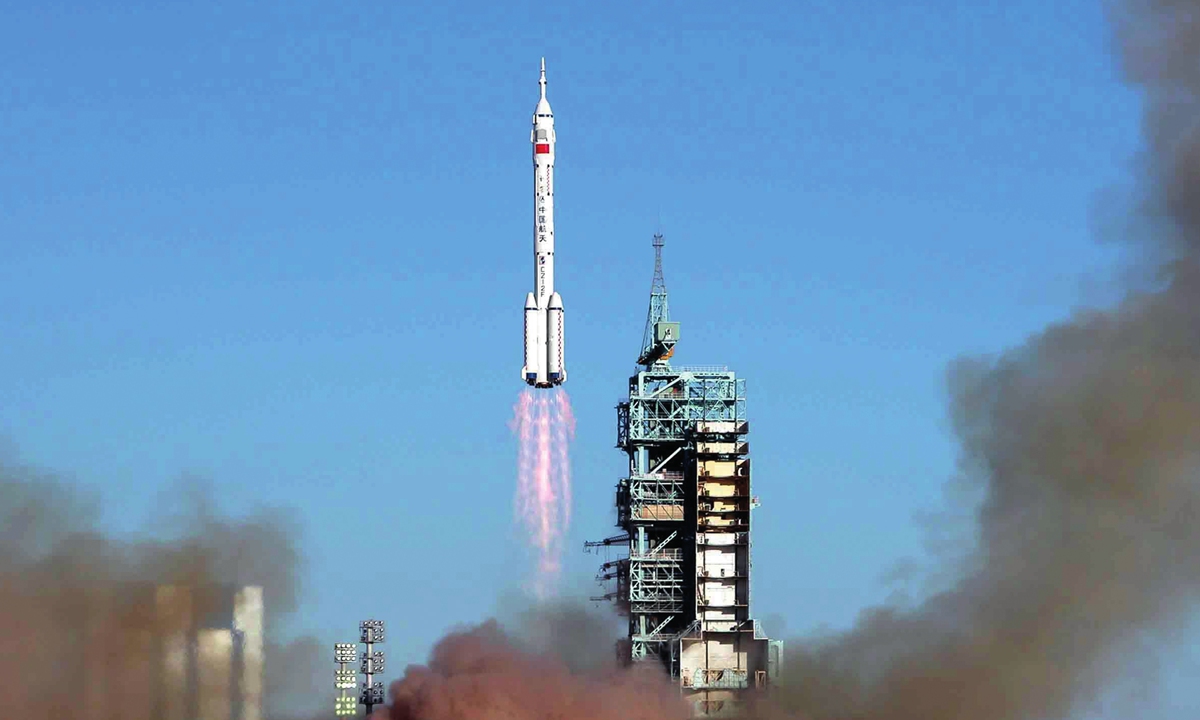
Shenzhou 5 spacecraft is launched into the space on October 15, 2003, carrying Yang Liwei, China’s first taikonaut. Photo: VCG
The Spirit of the Manned Space Program
China's Manned Space Program was initiated in the early 1990s with the outline of a three-step development strategy. In the program, Chinese scientists have created a tradition of relentless hard work under extreme and arduous conditions to solve critical problems and achieve many successes.
The Spirit of Model Workers
This spirit demonstrates a deep love for their professions and posts. They always strive to be the best, work diligently, and are eager to innovate and contribute.
The Spirit of the Qinghai-Xizang Railway Builders
The Qinghai-Xizang Railway completed in 2006 extends 1,956 km from Xining in Qinghai Province to Lhasa in Xizang Autonomous Region. It is the world's longest plateau railway at the highest altitude, and also the most challenging construction project in railroad history. The Qinghai-Xizang Railway builders were inspired by a courageous will to challenge their own physical and mental limits, and build a plateau railway of the best possible quality.
The Fighting Spirit of the Chinese Women's Volleyball Team
Over the past few decades, a couple of generations of Chinese women's volleyball players have overcome hardships to compete in the Olympics. The spirit is the general summary of the indomitable and brave fighting spirit of Chinese women's volleyball team - training hard and continuing to fight the tenacious struggle as a group.
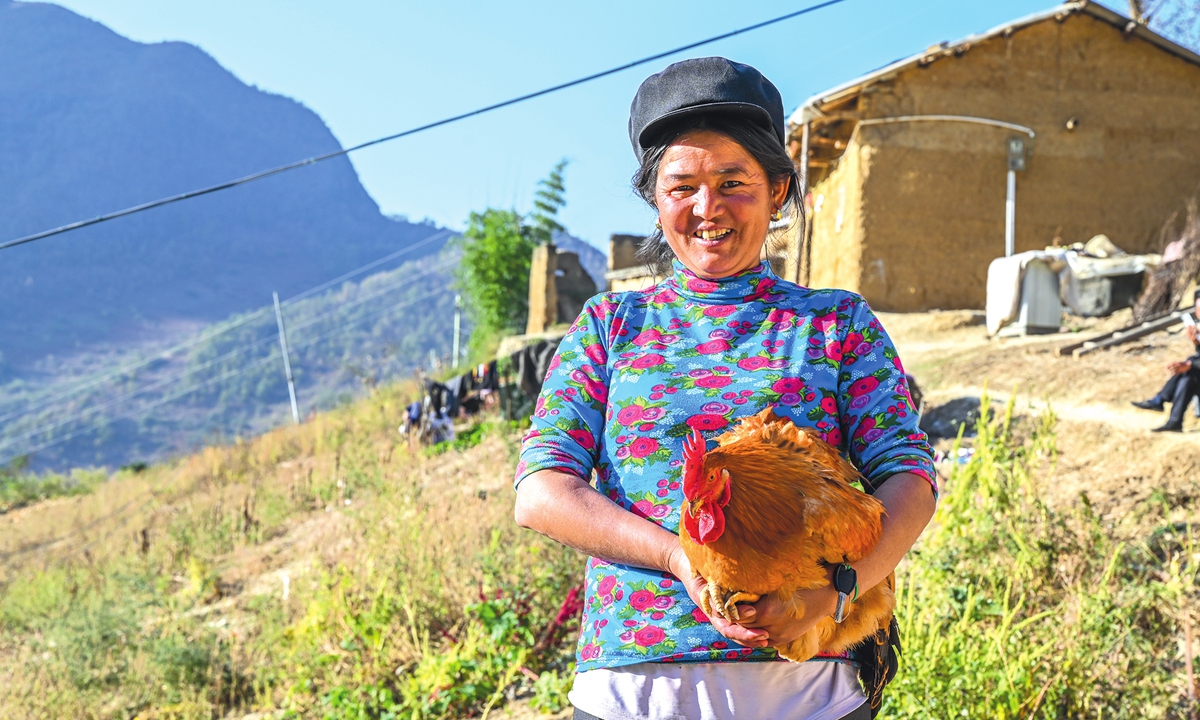
A woman from the cliff village in Sichuan Province shows off her rooster. Villagers now supplement their income by developing tourism. Photo: VCG
The Spirit of Winning Battle Against Poverty
The pragmatic, pioneering, and innovative spirit honed in the tough battle against poverty, is also a concentrated expression of patriotism, collectivism and socialism.

A woman recovered from COVID-19 along with two medical personnel wave after she was discharged from the hospital in Jiangxi Province on November 4, 2021. Photo: VCG
Socialism with Chinese Characteristics for a New EraThe Great Spirit of Fighting COVID-19
It features putting people's lives first, a nationwide solidarity, sacrifice, respect for science, and a sense of mission for humanity. This spirit continues to be an inspiration for the people across the country to bravely fight the COVID-19 epidemic.
The Spirit of the Ox
It represents the spirit of serving the people as willing steers, blazing new trails in development as pioneering bulls, and engaging in an arduous struggle as hardworking oxen.
The Spirit of Chinese Scientists
The spirit of Chinese scientists in the new era features patriotism, innovation, truth-seeking, dedication, teamwork, and the promotion of a younger generation of successors.
The Spirit of Entrepreneurship
Since China launched reform and opening-up in the late 1970s, a large number of entrepreneurs have emerged, creating and leading enterprises and building strong core competitiveness. The spirit of entrepreneurship is characterized by patriotism, professional dedication, law-abiding conduct, diligent work, innovation, pursuit of quality, and the courage to shoulder obligations and serve society.
Lunar Exploration Spirit
It means embarking on a new space exploration journey step by step, promoting the innovative development of China's space exploration cause, and making greater contributions to humanity's peaceful use of space.
Beidou Spirit in New Era
The spirit of the "independent innovations, unity and collaboration, overcoming difficulties, and the pursuit of excellence" reflected in China's exploration in BeiDou Navigation Satellite System (BDS-3).
The Spirit of the Silk Road
The ancient Silk Road was a trade route that spanned thousands of miles. More than this, it had been a platform for people-to-people and cultural exchanges, where ethnic, racial, religious, and cultural convergence took place down the centuries. The Silk Road spirit is embodied in peace and cooperation, openness and inclusiveness, and mutual learning and mutual benefit.
